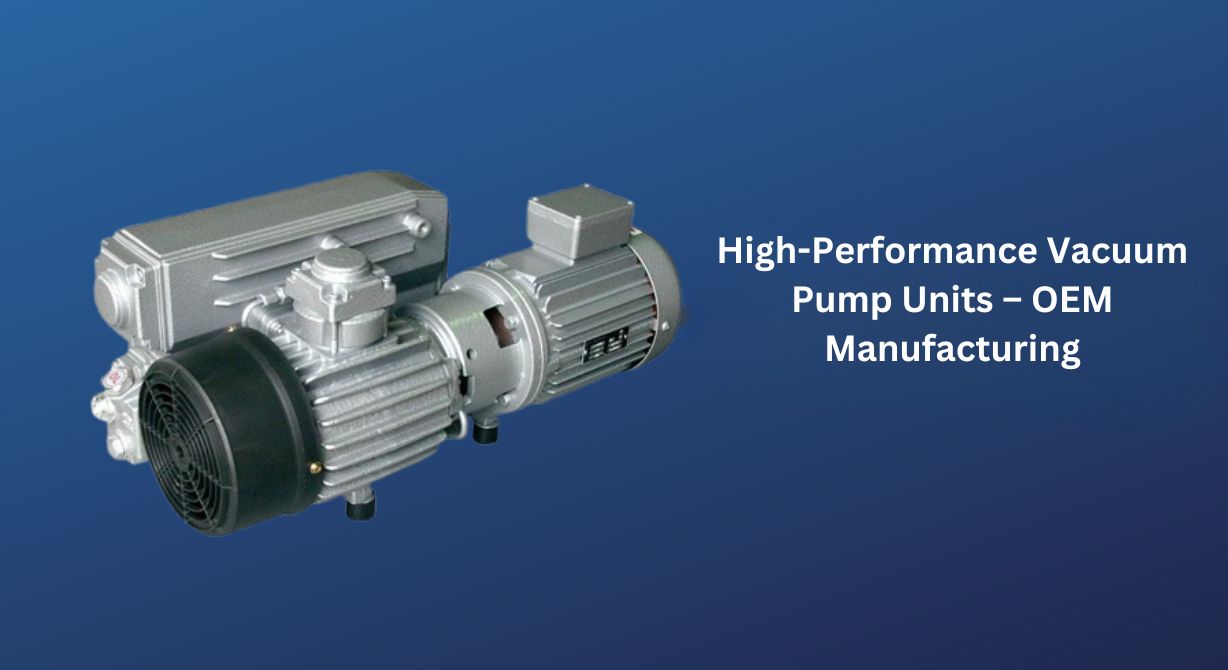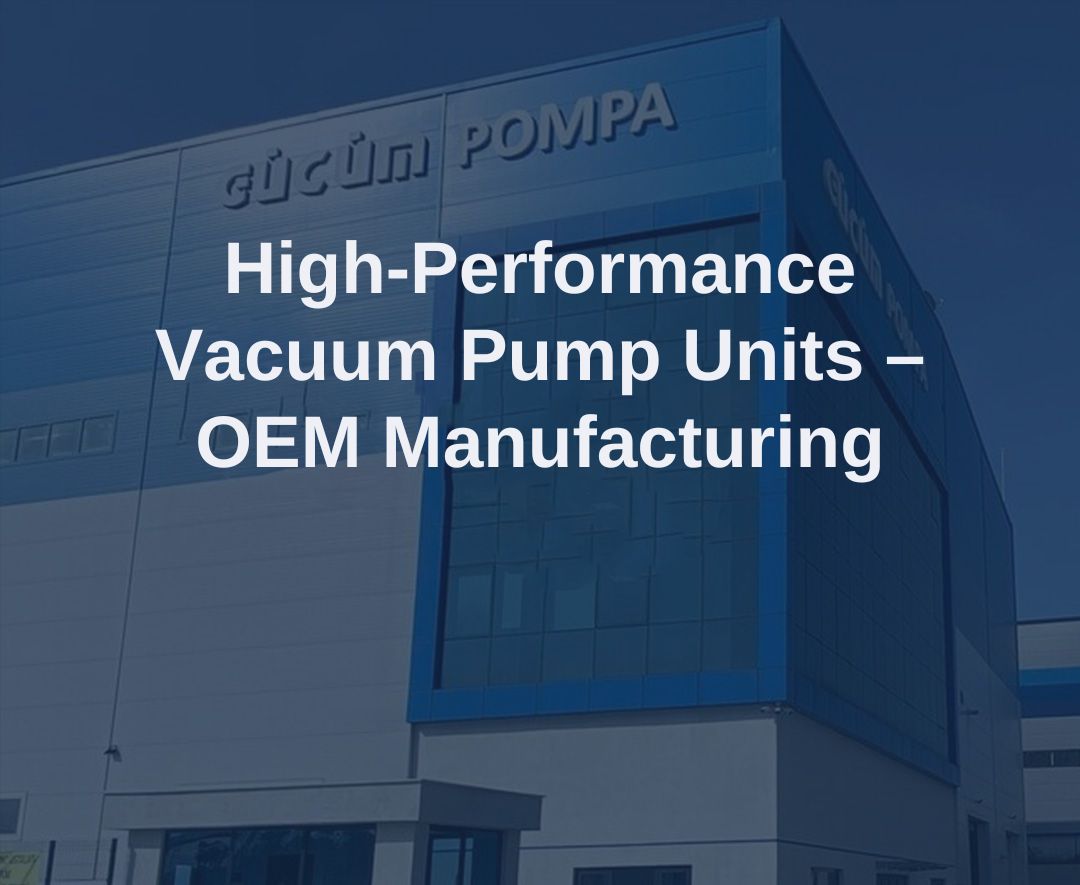High-Performance Vacuum Pump Units – OEM Manufacturing
Table of Contents
- What Should You Pay Attention to in OEM Vacuum Pump Production?
- Why Are High-Performance Vacuum Pumps Preferred in Industry?
- OEM Vacuum Pump or Standard Unit: Which Makes More Sense?
- Latest Technology Trends in High-Performance Vacuum Pumps
- Quality Standards for OEM Vacuum Pump Manufacturers
- Innovative Solutions That Improve Efficiency in Vacuum Pump Design
What Should You Pay Attention to in OEM Vacuum Pump Production?
Producing an OEM vacuum pump requires much more than a standard manufacturing process. Factors like performance, quality, and durability together directly affect your brand’s reputation in the market. The first step before starting production is to thoroughly analyze the needs and use scenarios of the target sector. This ensures that the vacuum pump unit is truly functional and long-lasting at the design stage.
Material selection plays a critical role in OEM vacuum pump production. While cutting costs by using cheaper components may seem tempting, this ultimately impacts customer satisfaction and increases maintenance costs. Using parts that meet high quality standards and resist wear and corrosion helps optimize the production process without compromising performance.
Another important detail is the testing and quality control processes applied during production. Confirming that each vacuum pump unit meets specified standards reduces return rates and strengthens reliability perception. Also, making design tweaks to improve energy efficiency provides a competitive edge in today’s market.
In terms of assembly and end-user experience, ease of maintenance is highly important. A modular vacuum pump allows only the relevant parts to be replaced during maintenance, instead of the entire unit. This shortens service times and lowers the total cost of ownership. All these steps are the key factors that bring long-term success in OEM vacuum pump production.
Why Are High-Performance Vacuum Pumps Preferred in Industry?
As criteria like efficiency, reliability, and energy savings become increasingly important in industry, high-performance vacuum pumps stand out by meeting these needs. Especially in sectors where continuous operation on production lines is critical, features like uninterrupted performance and low maintenance requirements offer major advantages. For industrial users, the most valuable factor is often the long life of equipment in the machinery park; here, vacuum pumps prove themselves through reliable technologies.
Another reason is the energy savings achieved through advanced engineering solutions. Modern vacuum pumps, with optimized designs, reduce operating costs and contribute to environmental sustainability. This helps companies build a strong image not just for performance but also for environmental awareness. Additionally, reduced noise levels and more compact structures improve ergonomics and the working environment in production facilities.
In sectors like chemicals, food, pharmaceuticals, and semiconductors—where sensitive production processes matter—vacuum pumps directly impact process safety and quality. The ability to provide uninterrupted vacuum contributes to final product quality and minimizes production losses. For all these reasons, high-performance vacuum pumps are considered long-term investments, and their popularity keeps rising each year.
OEM Vacuum Pump or Standard Unit: Which Makes More Sense?
When choosing a vacuum pump in industry, it’s common to debate between OEM solutions and standard units. An OEM vacuum pump, designed entirely for specific needs and processes, offers significant advantages—especially on production lines requiring high precision and performance. A design tailored to the specific requirements of the production line can outperform a standard unit in terms of energy efficiency and lifespan.
On the other hand, standard vacuum pump solutions are usually quicker to procure and generally more affordable. Their tried-and-tested designs simplify maintenance processes and make finding spare parts easier. This makes them preferable especially for lower-volume or general production lines.
Another factor to consider during decision-making is production volume and long-term plans. For large-scale or specialized manufacturers, OEM vacuum pump units increase process efficiency while providing brand-specific solutions. By contrast, for small and medium-sized facilities, standard vacuum pump options can provide adequate performance while lowering the initial investment cost.
Ultimately, the required performance, process-specific expectations, and budget balance are the main criteria that answer the question of whether an OEM or standard vacuum pump is the smarter choice.

Latest Technology Trends in High-Performance Vacuum Pumps
High-performance vacuum pumps that offer a competitive edge in industry are becoming smarter and more efficient thanks to recent technology trends. Especially, digital monitoring systems enable real-time tracking of pump performance, reducing the risk of breakdowns and lowering maintenance costs. This makes a real difference in sectors where uninterrupted operation on production lines is critical.
Energy efficiency is another prominent trend in modern vacuum pump designs. New-generation motor technologies and optimized airflow systems deliver both lower energy consumption and higher efficiency. Additionally, compact design saves space in production areas and makes installation easier.
Another notable innovation is modular design. Modular vacuum pumps can be easily scaled up or down depending on capacity needs. This adds flexibility for businesses and offers cost advantages in the long term. Furthermore, reduced noise levels and the use of more durable materials greatly improve user experience.
Smart control systems and IoT integration transform high-performance vacuum pumps from mere machines into data-generating tools that optimize processes. This boosts production efficiency while minimizing downtime and faults.
Quality Standards for OEM Vacuum Pump Manufacturers
For OEM vacuum pump manufacturers, quality standards are not just a preference but a key to global market competitiveness. These standards play a critical role in product reliability, performance, and longevity. Manufacturers use international quality management systems like ISO 9001 to keep production processes under constant control and minimize errors.
Another important issue is material quality. In OEM vacuum pump production, parts are rigorously tested for corrosion resistance, high-temperature durability, and wear performance. This provides industrial users with the reliability and low maintenance costs they need. In addition, detailed documentation of test protocols ensures traceability and makes it easier to identify the source of potential faults.
Energy efficiency is also central to quality standards. New-generation vacuum pumps are designed with lower energy consumption and reduced carbon emissions in mind. This helps not only the manufacturer but also the user contribute to a sustainable production process. Modular designs and systems equipped with smart sensors also simplify and speed up maintenance and control processes.
Certification and quality documents allow OEM vacuum pump manufacturers to build trust in the international market. These documents aren’t just formalities—they are concrete proof of product quality and help strengthen customer loyalty.
Innovative Solutions That Improve Efficiency in Vacuum Pump Design
Today, vacuum pump design isn’t limited to just producing more power; it also focuses on delivering energy-efficient and sustainable innovations. One of the most notable advances is vacuum pumps equipped with smart sensors and automation systems. These systems analyze real-time data and automatically adjust the pump to the required power level, reducing unnecessary energy consumption.
Another important development is aerodynamic design optimization. Redesigning blade shapes and airflow channels minimizes internal friction losses. This leads to both lower heat generation and longer service life. In addition, new-generation vacuum pumps take up less space on the production floor thanks to compact structures, while also simplifying maintenance processes.
Advancements in material technologies also directly impact efficiency. Lightweight alloys that withstand high temperatures and corrosion allow vacuum pumps to operate for long periods without performance loss. Meanwhile, the modular design approach allows parts to be added or removed as needed, shortening maintenance and repair times.
Vacuum pumps designed using digital twin technology are tested in simulations before production to reach ideal performance levels. As a result, businesses can optimize production processes with solutions that consume less energy, are more durable, and smarter.
Made in Turkey


